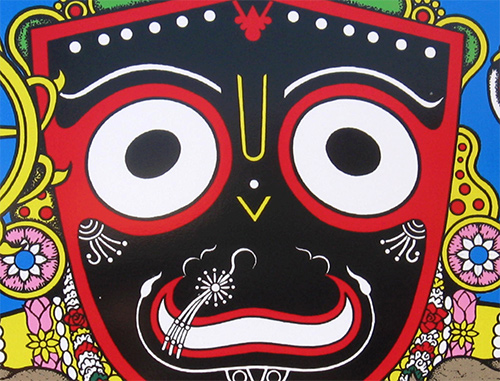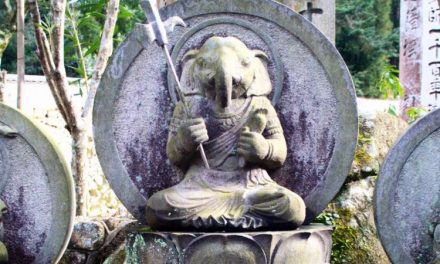
Lord Jagannath of Puri occupies a significant position in the socio-cultural and religious history of not only Orissa, but also India. The early history of Lord Jagannath is very difficult to know because of non-availability of facts and recorded history. Therefore it is difficult to bring out the real picture of Sri Jagannath during the ancient period.
What is known is that Puri is one of the foremost religious centres of India. While the culture of Sri Jagannath is still shrouded in mystery, many well known scholars and researchers are also trying to bring out the origin of Sri Jagannath. Eminent scholars have attempted to document the relation of Jagannath culture with Jainism, Buddhism and other cults.
In ancient times, Jainism spread all over Kalinga. Mahapadma Nanda, the king of Magadha, conquered Kalinga and took away the “Kalinga Jeena” image to Magadha. Pandit Nilakantha das argues that this Jeena image is actually that of Sri Jagannath. According to him, the word Jagannath is derived from Jeenanath. He also speculated that “Jagannath is primarily a Jain institution”.
The relationship between Jainsim and Sri Jagannath culture is quite interesting. Jain philosophers and devotees have also compared the Tri Ratna of Jainism with Sri Jagannath, Balabhadra and Subhadra. A prominent, historian, the late Kedar Nath Mahapatra, also supported this view. Some scholars advocate a theory of the Jain origin of Jagannath, primarily because there is great similarity between the images of Nilamadhava and Jain Tri Ratna. Jainism was very much popular in Orissa, and archaeological remains and Jain images recovered from various places of Orissa prove its importance. The Hatigumpha inscription of Kharavela highlights the worship of “Adijina” in Kalinga. This worship was done at “Pithunda”.
According to some scholars, Pithunda is identifiable with Puri. Nilakantha das argued that the Mahaprasad of Jagannath is Kaivalya, and he saw prasadam as a derivative of the Kaivalya, or the concept of salvation of the Jains. Of course, Vedic literature establishes the fact that maha-prasadam far predates Jainism.
Mahayan Buddhists propagated the speculative idea that the image of Lord Jagannath was really that of the Buddha. Tri Ratna of Buddhism — Buddha, Dharma and Sangha — are sometimes compared by Buddhists with Jagannath, Balabhadra and Subhadra. Some scholars have speculated as to the Buddhist origin of Jagannath. Their contrived theories go so far as to suggest that Brahma, placed at the navel of Jagannath, is nothing but the Buddhist tooth relic that was brought from Kusi nagar to Kalinga. Buddhists believe in worship of physical relics after death. The annual bathing ceremony (Snana Jatra) and the car festival (Ratha Jatra) are also seen as Buddhist practices.
The historian Cunningham also studied the writing of Yuan Chwang. The Chinese pilgrim speaks of Chelitola on the eastern seaboard. According to Cunningham, Chelitola was ” the present town of Puri.”
The Ratha Jatra of Jagannath is thought by some Buddhists to resemble the procession of the Buddhist image, as has been written by Fa-Hian. Buddhism does not believe in any class or caste distinction. During Ratha Jatra and other festivities, caste distinction is not found in the Jagannath temple, so Buddhists see this as an indication that the Jagannath cult came from Buddhism.
The term Jagannath was applied to Adi Buddha by Raja Indrabhuti of Sambal in his work Gyana Siddhi. Adi Buddha is even now called Jagannath in Nepalese Buddhism. Assimilation of Buddhism into Brahminical Hinduism book place after Buddha was taken in as the 9th Hindu Avatara (Incarnation of Lord Visnu), as shown on the panel of ten incarnations (Dasavatara) inside the Jagannath temple at Puri. The Dasavatara panels of Orissa frequently show Lord Buddha’s face with Jagannath iconography.
After the decline of Buddhism, Jagannath might have become the “New Buddha” to some of the faithful. The Jagannath cult did not belong to any particular sect, however, and as temple records indicate, its origin pre-dates both Buddhism and Jainism. It is the point of assimilation of all sects and religions.












hare krishna
Jai Jagannath
Mahavir was the 23rd guru of Jains. How can vedic cult predate Jain cult ? The Jains have been described in Hindu shastras and then Brahmins followed this cult.
Jagganatha is an Agamic concept not Vedic.
He is OMNIPOTENT/OMNIPRESENT/OMNISCIENT.
HARI OM TATSAT
You can check the Mookambigai Devi Photo in which one can see SriBudha vividly along with all other symbols connecting all religions in the world to one and only mighty god
Good attempt….With only assumptions and without any fact….
Few years before some people were believing that Mahabharat and Ramayan are stories. But now people started believing as real events happened and many evidences are comming out.
In similar note we should believe stories linked with Jagannath Mahaprabhu.
Lets understand that Jagannath is beyond arguments and disarguments
Jai Jagannath